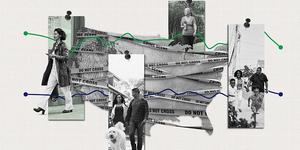What did we learn from the extraordinary circumstances of the 2000 presidential election? Survey research specialists from the media and academic worlds gathered last week for a symposium geared in part to address that question from the standpoint of pre-election polling. The event, which took place in Washington, D.C., was part of an annual series of conferences sponsored by the Gallup Research Center at the University of Nebraska-Lincoln. Gallup Poll Editor-in-Chief Frank Newport was on hand to present the rationale for pre-election polling (see "Horse Race Time Once Again" at right). Other presentations included:
The News in a Poll -- As Editors See It
Adam Clymer, chief Washington correspondent of The New York TimesA veteran Washington journalist, Clymer discussed the elements of polling stories that editors find newsworthy and those they ignore -- as well as the elements that media representatives should find important in polls. Clymer also talked about the reliance -- or over-reliance -- of news organizations on polls that they themselves conduct.
Do Pre-Election Polls Enhance Campaigns?
Susan Herbst, Professor and Chair of Political Science at Northwestern UniversityHerbst challenged several arguments in support of the role of pre-election polls in the democratic process. Among her points were the ideas that "horse race" polls tend to shift journalists' attention away from substantive policy issues; that they may discourage independent thinking among voters; and that they draw media coverage away from third-party campaigns. Herbst cautioned pollsters and political scientists not to lose sight of the need for lively public discourse, incisive campaign reporting, and an engaged citizenship.
New Data, New Methods: State-Level Election Forecasting During Election 2000
Simon Jackman, Assistant Professor and Victoria Schuck Faculty Scholar in the Department of Political Science at Stanford University
A New Approach to Estimating the Probability of Winning the Presidency
Edward H. Kaplan, William N. and Marie A. Beach Professor of Management Sciences at Yale University
One key reason the 2000 election was so difficult for pollsters to call can be summed up in two words: Electoral College. Most polling organizations randomly sample voters nationwide, with the assumption that the electoral votes will follow suit with the popular vote. As we saw in 2000, with an extremely close race that may not happen.
Jackman discussed an alternate approach: treating the presidential election as a series of interdependent state-level contests. Two conclusions followed from his findings: (1) uncertainty over state-level outcomes remains sufficiently large that in a close election like 2000, calling the result authoritatively is still risky; (2) polling organizations and election forecasters could do better by strategically allocating their resources across the country, focusing on key "swing" areas rather than using random nationwide samples.
Kaplan also discussed the disconnect between the popular vote and Electoral College results. He advocated using state-by-state voter surveys to estimate the number of Electoral College votes a candidate will receive. He also deduced how many voters should be surveyed in each state to best answer these questions, concluding that the sample sizes needed for reliable predictions are similar to those currently used for national popular-vote polling.
Using the Internet for Election Forecasting
George Terhanian, Senior Vice President of Research and Methodology for Harris Interactive
Web-based surveys have thus far been met with skepticism by many prominent public opinion pollsters. The key objections are that a) the number of Americans with access to the Internet is still not high enough to produce an online sample that's representative of all Americans, and b) online surveys therefore typically use non-probability samples -- that is, respondents aren't selected on a strictly random basis. Terhanian discussed the accuracy of Harris Interactive's Web-based pre-election forecasts of 2000 and argued that propensity score adjustment, a technique designed to minimize the biases associated with non-random samples, was a key reason for their success.
How Accurate Are the Polls?
Michael Traugott, Senior Research Scientist at the Institute for Social Research, Professor and Chair of Communication Studies, and Adjunct Professor of Political Science at the University of Michigan
Traugott evaluated the statistical performance of the pre-election polls in the 2000 presidential campaign and discussed a number of aspects that were new or unusual about that year's polls -- including a broader range of methodologies (e.g., Web-based polls) and statistical application, and the increased volatility of tracking polls. Traugott noted that, in light of that volatility and the closeness of the election, pollsters may want to reassess how they think about and measure the error introduced into their surveys.
